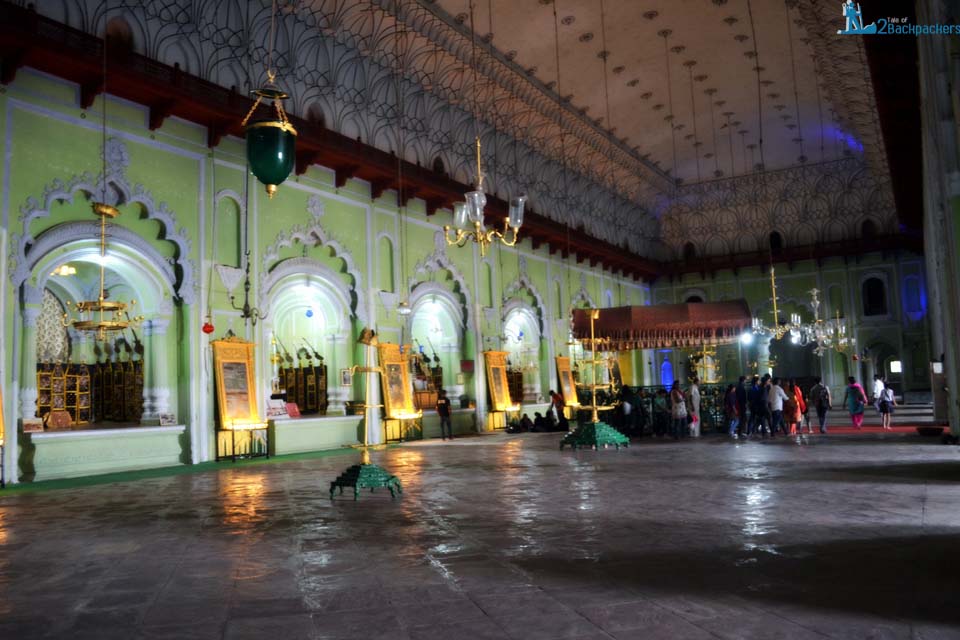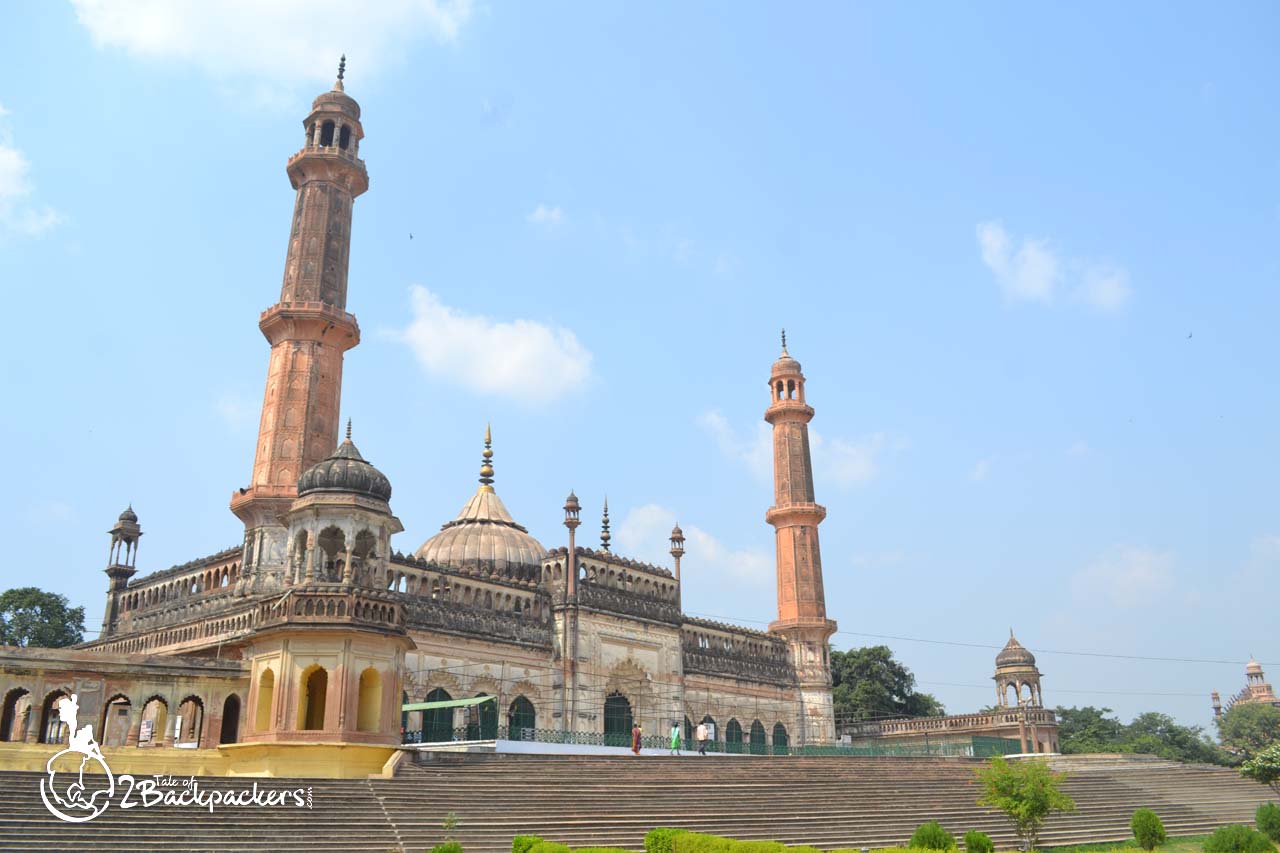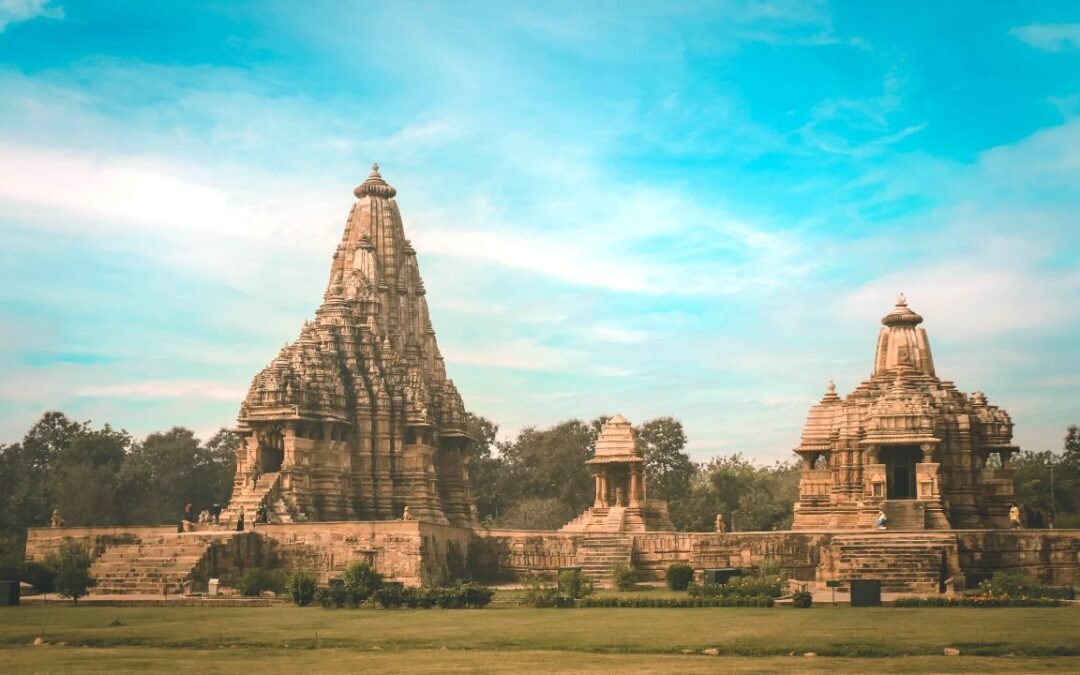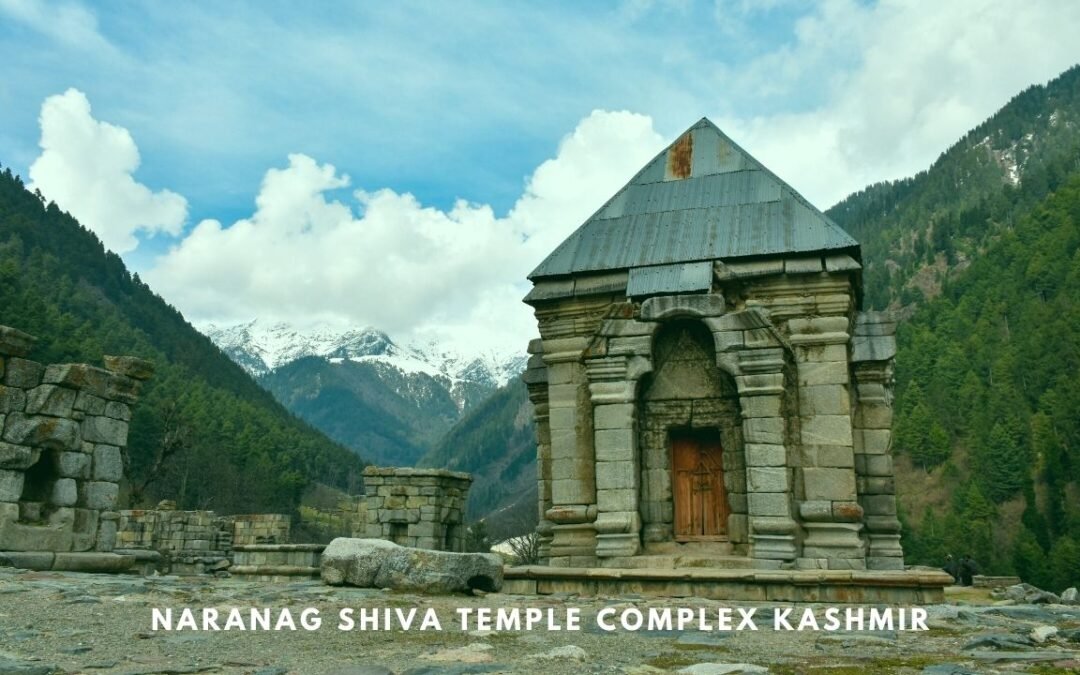I remember standing near one of the minarets and posing for a photograph when I had visited the Bara Imambara in Lucknow. That was a long time back, I was just a gawky teen then. Again when I came to Lucknow and entered the Bara Imambara complex, I had the urge to pose the same way! It did not happen somehow, but my desire to see the Bara Imambara in Lucknow again was definitely fulfilled.
In the city of minarets and domes, Bara Imambara stands as the most imposing and grand structure in entire Lucknow. The architectural and structural design of Bara Imambara is one of its kinds. The entire complex consists of the Imambara, mosque, Rumi Darwaza, Shahi Baoli, Naubat Khana and the Bhul Bhulaiya, perhaps the most interesting of all.

What is an Imambara?
An Imambara is neither a mosque nor a mausoleum. It literally means the residence of the Imam. It especially means an assembly hall where the Shiites Muslims gather together to have religious ceremonies during the Muharram, especially those related to Remembrance of Muharram. Throughout the month of Muharram and on other occasions important to the Shia Muslims, congregations are held in the Imambaras.
At early times, it was called ‘Hosayniya’ in Iran, Iraq etc. Hosayniya were built in the cities of Baghdad, Cairo, Aleppo during the 10th century originally in the form of annexe to mosques.
Imambara is primarily an Indian institution that had emerged in the eighteenth century. Safdar Jung had built a house for the purpose of observing the 10th day of Muharram, but he had not named the building as an Imambara. Later Nawab Asaf-ud-Daula from Awadh had built the famous Imambara of Lakhnau also known as the Asaf-i-Imambara. There are other imambaras in West Bengal as well like the Hooghly Imambara and Nizamat Imambara at Murshidabad.

Lucknow and its Nawabs – Who are the Nawabs?
In 1722, during the reign of Mughal Emperor Muhammad Shah, Mir Muhammad Amin Musawi or Saadat Ali Khan I was made the governor (also known as Subedar Nawab) of Awadh or Oudh province. Awadhw as one of the 12 provinces that Mughal emperor Akbar had carved out from his empire for administrative efficiency. Saadat Ali was the grandson of a rich trader from Khorasan (now in modern day Iran) who had migrated to India.
The term Nawab comes from the Persian word ‘Naib’ meaning deputy. The Nawabi rule in the province of Oudh started with Saadat Ali Khan I. Later in January 1775, Asaf-ud-Daula ascended the throne. The female counterpart of Nawab is known as Begum.

Asaf-ud-Daula was an eccentric Nawab
Nawabs had always been on the scrutiny of historians for being indecisive, flamboyant with the habit of excessive drinking and being servile to the British. Asaf-ud-Daula was the fourth Nawab of Awadh and he too had these qualities. But it was under his reign that Lucknow attained a majestic status and splendour. Asaf-ud-Daula had shifted the capital of Awadh from Faizabad to Lucknow as soon as he became the Nawab which contributed to its fantastic growth.
One of the most important outcomes was the emergence of a powerful Shia culture in Lucknow. The constant interaction with the Shia heartlands of Iran and Iraq had also made Lucknow culturally richer and a great intellectual centre.
But Asaf-ud-Daula was an eccentric and self-obsessed person. It is said that he would start laughing for no reason. He would abuse others and expected to be abused in return! He had immense respect for people who used obscene languages. Like most other Nawabs, he too was addicted to drinking and would drink along with his servants. But he had one great quality. He was very generous. A saying goes in Lucknow as
Jisey naa dey Maula, usey dey Asaf-ud-Daula
(he who is does not receive from God, is provided for by Asaf-ud-Daula)
And it was because of this generosity of the Nawab, the Bara Imambara was built. He was in fact, known as the architect of Lucknow.

History of Bara Imambara – who had built the Bara Imambara?
During 1784, Lucknow faced a devastating famine. The common people were mostly hit by this and they could not even get their daily rations. So they turned to their Nawab for help. Despite being his eccentric self, Asaf-ud–daula thankfully did not say something in the lines of Queen Mary Antoinette (If they do not have bread, let them eat cakes). He also did not give his subjects any charity but provided them with an opportunity to earn by working. He commissioned the building of the Bara Imambara so that that people would get employment.
The famine lasted almost for a decade. So to generate employment, the construction also continued for that period. It is said that one group would build the structure in the morning while the nobility would dismantle it at night. In this was the people were never out of work for the entire famine period. The nobility was also paid for this and the Nawab also helped the noblemen in this way. Almost 20000 people worked in the construction of the Bara Imambara.
Did you know, that the modern day Biriyani (a dish with rice and meat) is said to have born out to feed the workforce!
I do not know whether Biriyani was the brainchild of the Nawab or his cook, but a great dish did come out from this work. Bara Imambara was completed in 1881 and still stands today as the pride of Lucknow as well as India.

Unique architecture of Bara Imambara in Lucknow
The Bara Imambara is magnificently built. Just as we entered the Imambara, we were awed by the grand structures, the sprawling gardens and the huge gates. Everything was on a grand scale. Located in the heart of Lucknow, Bara Imambara is impressive and unique in its architectural setting, design and execution. It rivalled the Mughal architecture. There are plenty of interesting facts about this impressive monument, mostly related to its architecture.
The main gateway has three arches and is rectangular resembling the tripolia of Mughal architecture. There is a dual fish motif etched in the main gateway. This was the symbol of the Nawabs and is found in most of the structures commissioned by them. The royal flag of Awadh also had the dual fish structure.

As we entered through the gate, we came across the huge forecourt after which there is another gateway. This one also had three arches. From this gate, we finally entered the Bara Imambara courtyard. Once we entered the courtyard, we simply gaped in amazement at the sheer scale of the entire complex. Straight ahead is the Bara Imambara, to the right is the Asifi Masjid and to the left is the Shahi Baoli. We stood in awe and respect for a few moments before entering the Bara Imambara. Such a place deserves respect!

Chambers within the Bara Imambara in Lucknow
The Bara Imambara is the grandest of all the other Imambaras in the country. You need to remove your shoes to enter inside the Imambara. Inside there are the three Halls known by different names. To the east is the Chinese Hall with beautifully decorated domed ceilings. The central hall is known as the Persian hall and is the largest one.
What is interesting is that the large Persian hall measuring 170 ft X 55 ft X 15 ft, was built without any columns. The arched roof of the central hall does not have a single beam or girder. It is said that this is the largest building of the world without any pillar support. No wood or iron was used in the construction. The extremely heavy roof is supported by the arched passageways on the first, second and third floor, also known as the Bhulbhulayia or Labyrinth. The passageways and corridors of the Labyrinth were so built as to create air cushions that would support the weight of the vault.
When it was constructed, the French Major Gen. Claude Martin had expressed doubts about the longevity of the roof. He was afraid that such large and unsupported structure would collapse once the wooden supports were removed. To stop his critics, Kifayatullah ordered his bed under the roof and he himself lay down there while the supports were being removed.
Well, the roof did not collapse then and it still remains in all its glory surprising its visitors. Hats off to his confidence!
The Final Hall is known as the Kharbooja Hall or Watermelon Hall. Its domed ceiling is said to resemble watermelons, hence the name! But I did not really find anything Chinese in the Chinese Hall. Cannot account for such a peculiar name.
There is a beautiful story about how Nawab Asaf-ud-Daula acquired the land where the Imambara was built. On the land where Bara Imambara stands today was the hut of an old lady named Lado Saquum. The Nawab being a generous man sent his men to the lady to inquire what she wanted in return for the land. She did not want any monetary compensation. She only wanted the Nawab to take responsibility of her Tazia.
For the uninitiated, a Tazia is the representation of the tomb of Hassan and Hussain, who were killed in the battle of Karbala in 680 AD. The Tazias are carried by the Shia Muslims at the processions during Muharram. At Lado Saquum’s request, her Tazia is still kept inside the Bada Imambara and is taken out during the Muharram processions in Lucknow.
At the centre of the main hall lies the graves of Nawab Asaf-ud-daula, his wife and the architect Kifayatullah. It is said that when the Nawab wanted to reward Kifayatullah for his service, he only wanted “Do Gaz” or grave plot from his master. Thus honouring the architect’s wish, his grave, too, lies beside the grave of the Nawab. At death, everyone becomes equal.

The Bhul Bhulaiya
Bhul Bhulaiya or the Labyrinth is constructed above the Imambara. It comprises of almost 1000 passageways and 489 identical doorways that gives the feeling of getting lost. The Bhool Bhulayia was built in such a way to accommodate the design of the central hall. The Lucknow Bhool Bhulayia consists of a series of maze – a path breaking into multiple paths and they break down into other paths.
At Bhulbhulaiya, you will get a demonstration of the amazing acoustics of the place. A match struck at one end of a passage can be heard from the other end.

Shahi Baoli
The Shahi Baoli is built in a rectangular plan and has seven levels. The top three stories are said to be above the water level and the lower four levels of this block were supposed to be under water. Inside the rectangular block, there is another octagonal block built around the pit of the well. There are cells and passages at every level. The water that was present there used to be used for both drinking and gardening purpose. You will not find any water today, but if you have taken a guide with you, he would take you to a place that still has a small portion of water. Here he demonstrates the ingenuity of Kifayatullah, the architect. From some particular cells inside the octagonal structure, a person can see the reflection of anyone who is trying to enter the Baoli while himself remaining undetected.
“This was the CCTV camera of that age”, said our guide in his inimitable Lucknowi style.

Asifi Mosque
The mosque lies on the western side of the complex and stands on a raised platform with a flight of steps. With two towering minars on either side, the mosque is an eye-catching structure. There is a board in front of the mosque saying “Non Muslims are prohibited from entering the mosque”. So we marvelled at the mosque from outside and returned.

Rumi Darwaza
The Rumi Darwaza is just 100 metres from the Bada Imambara and is one of the most beautiful and grand gates I have seen. The gateway is fit for a royal welcome. The mammoth ornamented arch of the Rumi Darwaza through which you can enter the old city was modelled on Istanbul’s gateway, Sublime Porte. Rumi Darwaza is also known as the Turkish Gate. Rumi Darwaza is one of the most iconic structures in Lucknow just as Victoria Memorial is for Kolkata.
The gateway is 60 feet in height in the form of a huge archway having a double storeyed octagonal pavilion on either side. It looks different from either side. At one side it looks like a mihrab (a semicircular niche in the wall of a mosque) while on the other side, it looks like tripolia gate (gates having three passageways). The architecture of the Rumi Darwaza is in Nawabi style though it has some Mughal style. The Chhatri is beautifully carved and can be accessed by a flight of stairs.
We admired at the beautiful Rumi Darwaza at length but realized that it is quite difficult to get a proper picture of the gateway with so many electric poles and traffic on the road. From the Rumi Darwaza, the clock tower can also be seen at a distance.

Nahbat Khana
Nahbat Khana or Nakkar Khana is also a part of the complex. This was the place where music was played for special occasions and the arrival of the nawabs and other dignitaries were announced by beating drums.
The Bara Imambara of Lucknow is truly an unparalleled pre industrial engineering, a unique structure with different architectural styles. The more we see it, the more we marvel at it. The entire complex with its structures, terraces are simply magnificent. The view from the terrace of the Bara Imambara is also stunning. You can see the entire complex as well as the Lucknow city from the terrace of the Imambara.

Some Tips:
Bada Imambara is located at Hussainabad area of Lucknow and can be easily reached by car or auto rickshaw.
The Entry Tickets to Bara Imambara costs INR 50 and it includes the entrance to the Imambara, Shahi Baoli and the Chhota Imambara. The ticket price is INR 500 for foreign tourists.
The entry timing is between sunrise to sunset.
You can hire guides for a tour of the Bara Imambara. We would recommend you for the same because having a guide can be quite fun. They would speak in their Lucknowi tehzeeb and will tell you stories and trivia about the Bara Imambara.
If you are claustrophobic, think before going inside the Bhulbhulayia and definitely let your guide know about it.
You need to remove your shoes before entering the Imambara and mosque.
There are restrooms and drinking water facilities inside the complex. Do carry your water bottle while roaming around.

How to reach Lucknow?
Lucknow is well connected with other major cities by air, road and rail. Lucknow is very well connected by trains from Delhi and Howrah.
Once you are in Lucknow, you can hire a tonga (horse pulled carriage), rickshaw or car to reach Bara Imambara. We had hired an auto to visit the various attractions of Lucknow for the day.
Where to stay in Lucknow?
There are numerous hotels available at the major places in Lucknow. It is recommended to stay at any of these places -near Charbagh Railway station, Gomti Nagar or Hazratganj. Charbagh and Gomti Nagar have some budget hotels while Hazratganj is comparatively costlier.
Did you like the post? Let us know about your thoughts by commenting below. You may also Pin it for a later read!











Beautiful pics, loved the view from terrace.
Amazingly written post
Bara Imambara looks really beautiful.. If I ever visit Lucknow, I would surely visit this place…Thanks for sharing!